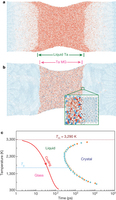Materials scientists have long sought to form glass from pure, monoatomic metals and Scott X. Mao, a Professor of Mechanical Engineering and Materials Science at the University of Pittsburgh, and colleagues have done it.
How was it accomplished? It's long been conjectured that any metallic liquid can be vitrified into a glassy state provided that the cooling rate is sufficiently high. As is said about the original alchemy, turning lead into gold, it is now simply a matter of having enough energy. But this of vitrification single-element metallic liquids has needed more than just high energy.
Metallic glasses are unique in that their structure is not crystalline (as it is in most metals), but rather is disordered, with the atoms randomly arranged. They are sought for various commercial applications because they are very strong and are easily processed.

Atomic configuration showing a liquid zone of Ta 35 nm in length after Joule heating (at t = 0 ps). The atoms are coloured on the basis of their degree of disorder represented by local bond-orientational order parameter. Credit:
doi:10.1038/nature13617
The novel method of creating metallic glass involved in the recent paper developing and implementing a new technique (a cooling nano-device under in-situ transmission electron microscope) that enabled him and his colleagues to achieve an unprecedentedly high cooling rate - 1014 K s−1 - that caused melts of pure refractory body-centred cubic (bcc) metals, such as liquid tantalum and vanadium, to be vitrified to form metallic glasses.
Mao says, "This is a fundamental issue explored by people in this field for a long time, but nobody could solve the problem. People believed that it could be done, and now we're able to show that it is possible."






Comments